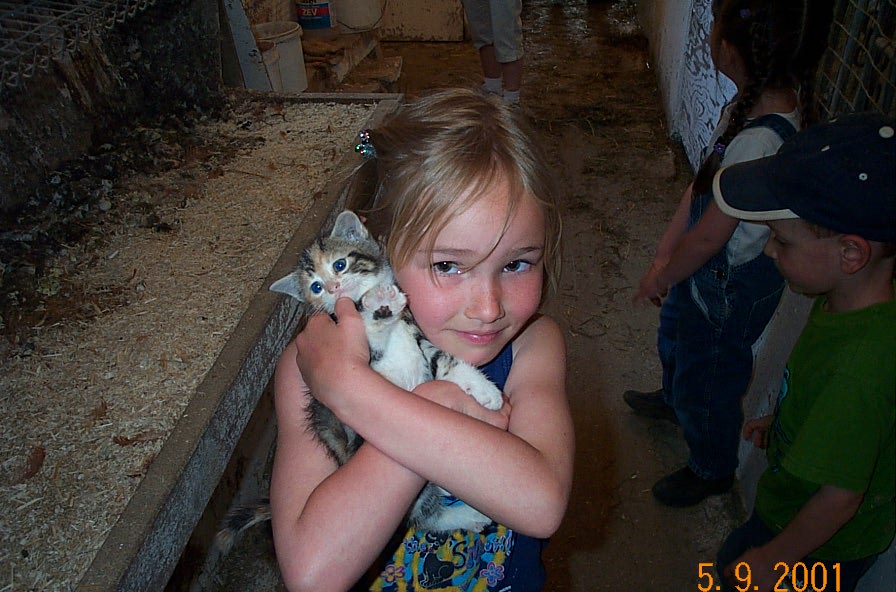In 2004, 187 people became ill with E. coli O157 after visiting the North Carolina State fair in Raleigh. One of those visitors was a two-year-old who was hospitalized for 36 days with hemolytic uremic syndrome. That led to the passage of Aedin’s Law, which directs the Commissioner of Agriculture to adopt rules establishing sanitation requirements for petting zoos and animal exhibitions.
The law says that all animal events need to be permitted, and it is the responsibility of the permit holder to follow rules around signage, education, provision of handwashing facilities and  risk-reducing animal care and management practices. Changes happened because a bunch of people got sick.
risk-reducing animal care and management practices. Changes happened because a bunch of people got sick.
In 2011, 25 attendees at the same fair acquired E. coli O157 by walking through the Kelley Building where a livestock competition was held. The epidemiology didn’t point to animal contact as a risk factor. In response to the outbreak, Ag Commissioner Steve Troxler formed a multiagency group to evaluate management practices and come up with changes to be implemented at future events.
These changes were released last week and focus on limiting access to animal areas (including show areas and washing areas where the poop is knocked off of animals), increasing the availability of handwashing stations, evaluating their use, and increased communication about risks.
Not sure what that last one means.
Outbreaks of zoonotic disease at petting zoos demonstrates that although contact with animals in public settings (such as fairs, petting zoos, and schools) can provide educational and entertainment opportunities, the potential to spread disease exists at these events if proper hygiene measures and precautions are not taken and reinforced. Human illness outbreaks have been linked to visiting petting zoos or similar settings with animal contact in the U.S., Canada, U.K., New Zealand, Australia, Ireland and the Netherlands.
The U.S. Centers for Disease Control and Prevention (CDC) has documented approximately 150 outbreaks of human infectious disease involving animals in public settings from 1996-2010.
Children have an increased risk of infection in animal-contact settings due to certain factors and behaviors, including lack of awareness of the risk for disease, inadequate handwashing, lack of close supervision, and frequent hand-to-mouth activities (e.g., use of pacifiers, thumb-sucking, and eating).
In the fall of 2009, an E. coli O157:H7 outbreak at Godstone Petting Farm in the U.K resulted in 93 illnesses – primarily little kids.
The investigation into the Godstone outbreak identified evidence of environmental contamination outside the main barn, indicating acquisition of illness through both direct animal or fecal .jpg) contact, and indirect environmental contact (e.g. contacting railings or soiled footwear).
contact, and indirect environmental contact (e.g. contacting railings or soiled footwear).
Aerosolization of potential pathogens is also possible, as suggested in an E. coli O157:H7 outbreak at a county fair in Oregon, in which 60 people fell ill.
As part of the response to the Godstone outbreak, U.K. health types recommended handwashing stations with soap and water only (no wipes or sanitizers, because they don’t work that well under certain conditions).
Ihekweazu et al. subsequently concluded that in the Godstone outbreak, “handwashing conferred no demonstrable protective effect. …
“Moreover, from the findings of many previous published studies, it must be assumed that all petting or open farms are potentially high-risk environments for the acquisition of VTEC O157 infection.”
Against this backdrop, the Raleigh News Observer wrote in an editorial last week that Commissioner Troxler has instituted some common sense changes to the fair like limiting contact with animals and moving some food vendors away from the animal buildings.
That may be common sense after two E. coli outbreaks at the same fair, but it’s not common sense unless organizers have actually thought about it. At the Ekka yesterday in Brisbane, we saw untold amounts of food, water bottles, pacifiers, and baby bottles being consumed or transported, all while petting animals through a fence.
Troxler also said, “Handwashing, handwashing, handwashing.”
This means that as folks go through the fairgrounds, they ought to take advantage of well-placed handwashing stations and lather up (or use sanitizer) often. Very often. And it means giving the little ones a frequent handwashing exercise as well.
Sanitizers have limited effectiveness, and in a petting zoo situation, so does handwashing; it’s only one component of an overall strategy to reduce risk. But it’s easy to say handwashing because that blames the patrons, not something else.
A table of petting zoo outbreaks is available at http://bites.ksu.edu/petting-zoos-outbreaks.
